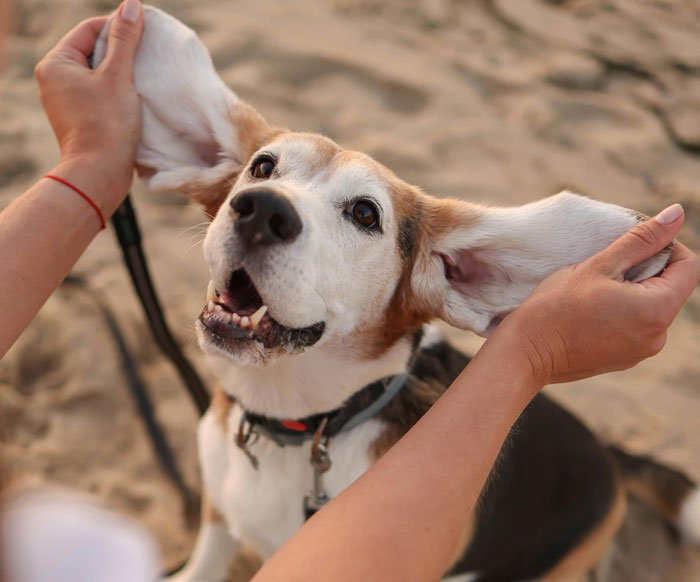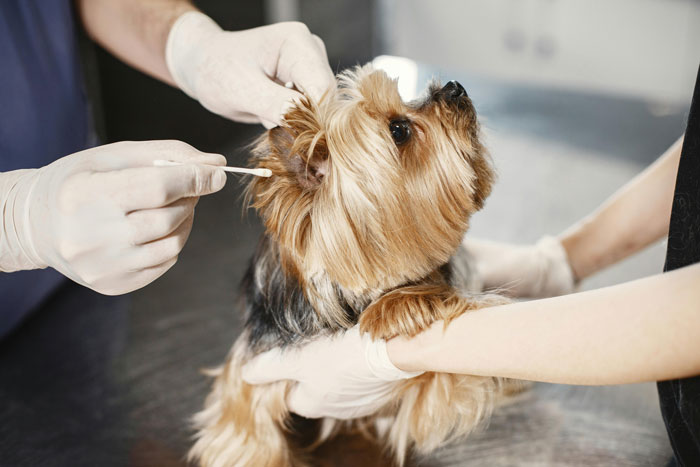
Step-by-Step Guide How To Clean Your Dog Ears at Home: Tips & Tricks
Grooming is not just a luxury; it’s a necessity for your dog’s health & happiness, and ear cleanings are a fundamental part of your dog’s routine. Imagine your pup, snuggled on the couch, head resting contentedly on your lap. Suddenly, their head shoots up, eyes wide, followed by a vigorous head shake and a frantic paw at their ear. That’s the ear trouble!
- Dogs with allergies or floppy ears are more susceptible to ear infections and issues.
- Cleaning a dog’s ears once a month is generally sufficient, but some may need weekly cleaning.
- Important to use dog-specific ear cleaner and avoid substances like alcohol or hydrogen peroxide.
- Professional care is advised if a dog shows pain, unusual odor, or behavioral changes related to ear health.
Do you know that ear problems are most common in dogs? And this is because their ears are shaped in a way that makes them get ear issues often. A study in the UK found that a surprising 7.3% of dogs get ear infections every year. Many things can cause these ear problems & some dogs keep having them all their life.
But don’t worry! While ear issues are common in our furry friends, with a little know-how, we can become masters of doggy ear care. No vet bills are necessary – although they’re always there for trickier situations!
So if you’re ready to learn the ins and outs of this vital grooming task, keep reading. This guide is your one-stop shop for understanding why dog ears get gunky, how to clean them safely and effectively, and when to call in the professionals. We’ll also sniff out the best cleaning solutions and answer all your burning questions.
The information provided herein is for informational purposes only. Please refer to our disclaimer for more details..
- What Causes Dirt & Ear Infection in the Dog’s Ears?
- How Frequently Your Dog’s Ears Need Cleaning?
- Dog Ear Cleaning Rules to Follow and Mistakes to Avoid
- Materials Required To Clean Your Dog’s Ears
- 11 Easy Steps To Clean Dog Ears
- The Best Dog Ear Cleanser
- When You Should Avoid At-Home Ear Cleaning
- Conclusion
What Causes Dirt & Ear Infection in the Dog’s Ears?
Understanding the root causes of dirt in your dog’s ears is crucial for effective entire ear care. Dog ears are shaped like an “L” and are longer than ours. This shape easily traps stuff like dirt, wax, water, and leaves. Because of their shape, dogs can’t clean their ears well – even if they shake their head or scratch.
Certain breeds, particularly those with floppy ears like Cocker Spaniels and Shih Tzus, are more susceptible to ear issues. Their floppy ears may trap more wax & dirt, and there’s less airflow, which means more infections. Additionally, dogs with hair in their ear canals have similar problems. The hair holds onto dirt and moisture.
Ear infections are also common in dogs with allergies. These allergies can be from things like pollen or certain foods like chicken eggs, wheat gluten soy, etc. Allergies make dogs itch, which weakens their skin and can lead to inflaming and infections, not just in the ears but in other body parts too. About half of the dogs with allergies are prone to ear infections. And for dogs with food allergies, over 80% of them have ear problems.
Other things that can cause ear issues in dogs include:
- Endocrine diseases such as hypothyroidism.
- Warm and moist ear canals are perfect for bacteria and yeast to grow.
- Too much ear wax.
- Stuff like grass or hair getting into the ears.
- Ear mites.
- Autoimmune diseases.
- Injuries to the ear canals.
- Cleaning the ears too much or using the wrong products can make things worse.
Older dogs often have ear problems too. This is because their skin gets thicker and they’re more likely to get infections. Diseases more common in older dogs, like Cushing’s disease & hypothyroidism, can also make ear problems more likely. As dog owners, knowing all this helps you keep your dog’s ears healthy. Regular ear cleaning is an important part, especially for dogs that get infections easily.
How Frequently Your Dog’s Ears Need Cleaning?
Determining how often to clean your dog’s ears depends on several factors including their breed, lifestyle & health conditions. Usually, cleaning your dog’s ears once a month is fine.
But dogs with floppy ears and those with long ears, like basset hounds, and dogs that love swimming or playing outside need frequent ear cleaning i.e., every other week, or maybe even every week.
Remember, cleaning their ears too much can cause irritation or infections. And always make sure to dry your dog’s ears well after they have a bath or go swimming. If you’re not sure how often to clean their ears – it’s a good idea to ask your veterinarian for advice.
Dog Ear Cleaning Rules to Follow and Mistakes to Avoid
So before you start cleaning your dog’s ears, there are some important rules to follow and some mistakes you should avoid. This makes sure it’s a good experience for both you and your pet.
Do’s for Dog Ear Cleaning:
- Use a Dog-Specific Ear Cleaner: Always choose an ear-cleaning solution formulated for dogs. Because these products are designed to be gentle and effective for your pet’s specific ear structure.
- Grooming: If your dog has lots of hair in their ears – groom them before you clean. Cutting the hair around & inside the ears helps make cleaning easier and better.
- Reward Your Dog: Make ear cleaning a positive experience. So give your dog treats during and after cleaning. And this makes them link ear cleaning with happy times.
- Gentleness is Key: Be gentle when you clean their ears. Dog ears are delicate, especially if they are already dirty or infected. And so being too rough could hurt their ears.
- Consult Your Vet: Every dog is different, so the number of times you clean their ears can vary. Ask your vet what’s best for your dog’s breed, lifestyle & ear health.
- Start Early: If you can, get your dog used to ear cleaning when they are young. However if you start when they’re older, do it slowly so they get used to it.
- Stay Positive: Your mood affects your dog. So stay calm and cheerful to help your dog relax.
Don’ts in Dog Ear Cleaning:
- Avoid Harmful Substances: Don’t use cleaners with alcohol or hydrogen peroxide. Because these can irritate and damage your dog’s ears.
- No Q-tips: Avoid cotton-tipped applicators for deep ear cleaning – they can push dirt far into the ear canal and might damage the eardrum.
- Water Isn’t Ideal: Don’t use water to clean your ears. It doesn’t get rid of ear wax well & can trap more dirt.
- Don’t Pluck Ear Hair: Don’t pull out ear hair unless a vet says it’s okay. As it can hurt and be bad for your dog.
- Seek Professional Advice: If you’re not sure about how to clean your dog’s ears, ask your vet for help.
Following these tips will help you keep your dog’s ear cleaning safe, comfy & effective.
Materials Required To Clean Your Dog’s Ears
To clean your dog’s ears safely and well, you need a few key things:
- Soft towels: These are for drying & cleaning up any messes.
- Comfortable clothes: Wear something you don’t mind getting dirty or wet.
- Clean Cotton balls or gauze pads: Use these for gentle cleaning.
- A special ear wash solution for dogs: This is made just for cleaning dog ears.
- Tweezers: You’ll need these only if your dog has hairy ear canals. And, you need to remove some hair carefully.
11 Easy Steps To Clean Dog Ears
Now that you understand the reasons behind dirty dog ears & have some cleaning tips – let’s go through the 11 easy steps to clean your dog’s ears. This will make the process easy and enjoyable for everyone.
- Prepare Your Supplies: Get a dog-specific ear cleaning solution, either from a store or your vet. Have soft, non-abrasive wipes ready, like pieces of a clean old T-shirt, makeup remover pads, gauze, or cotton balls. And if your dog requires medication for their ears, keep that within reach as well.
- Secure Your Dog: To keep your dog still during cleaning, gently hold them in a comfortable position. And, doing this in a small area, like a bathroom, can help you use your arms or body to keep them calm.
- Expose the Ear Canal: Lift and hold the ear flap your dog gently to see the ear canal. This is important for cleaning the right area & putting in the cleaning solution properly.
- Apply the Cleaning Solution: Now fill the ear canal of your dog with cleanser. You can do this in two ways:
- Either, pour the solution straight into the ear canal, making sure the bottle doesn’t touch the ear.
- Or soak a cotton ball in the solution and put it in the ear.
Ensure the cotton ball isn’t too small to avoid it sliding deep into the ear canal.
- Massage the Ear Base: Whether you apply the solution directly or use a cotton ball, next – gently massage the base of the ear for about 30 seconds. Because, this helps the solution to work effectively, breaking up wax and debris. And you’ll hear a squishy sound if the cleaner is working.
- Let Your Dog Shake: Allow your dog to shake his head. This is good as it helps loosen and bring debris to the surface of the ear canal.
- Wipe Out the Ear: After the massage, use gauze or a cotton ball to gently clean the ear canal. So wrap your finger in gauze, gently wipe inside in a circular motion, then pull out to get rid of the dirt.
- Repeat if Necessary: Sometimes, you need to do steps 4-7 again, especially if there’s a lot of dirt.
- Clean the Ear Flap: After the canal is clean, use a damp cotton ball or wipe with ear wash to clean the inside of the ear flap.
- Inspect Your Work: Make sure you didn’t leave any cotton or gauze inside the ear. Leftover material can be uncomfortable or cause infections.
- Apply Medications: If your vet has given you ear medications for your dog, apply them as instructed.
By following these steps, you can clean your dog’s ears effectively at home. This keeps them healthy and comfortable. Remember, if you have any worries or questions about cleaning your dog’s ears, it’s always best to talk to your vet immediately.
The Best Dog Ear Cleanser
Choosing the best ear cleanser for your dog is really important, especially if they often get ear infections. For such cases, a medicated ear-cleaning solution might be necessary. These special cleaners work by drying out and making the ear canal more acidic. This stops infections from happening as easily.
It’s really important to talk to your vet before you pick an ear cleaner. They can suggest one that’s just right for your dog, making sure it’s safe & works well. While you might see homemade ear cleaners online – it’s better not to use them. DIY mixtures often have things like vinegar, hydrogen peroxide, or alcohol. These can irritate or even damage your dog’s sensitive ears. Always go for products that your vet approves of. And remember, if your vet has given you ear medication for your dog, put it in clean ears so it works the best it can.
When You Should Avoid At-Home Ear Cleaning
While most dogs require regular ear cleaning to maintain your dog’s ear health, however, if your dog appears to be in pain, it’s best to avoid at-home cleaning and seek professional veterinary care. Watch out for these signs that might mean your dog has an ear infection or other problems:
- Unusual Odor: If your dog’s ears smell strange or bad, that’s a big warning sign.
- Abnormal Discharge: Excessive ear debris, especially if it’s unusually colored like black or red, is a cause for concern.
- Visible Irritation: Don’t ignore it if the inside of your dog’s ear looks red or swollen.
- Behavioral Changes: If your dog, who normally doesn’t mind ear cleaning, starts to resist, shows pain, or keeps tilting their head – these could be signs of discomfort or infection.
- Physical Signs: Too much scratching at the ears, shaking their head, or rubbing their head on things can mean that the dog may have irritated ears.
- Pain Reaction: If touching your dog’s ears makes them cry, whine, or look like they’re in pain, it’s time to see the vet.
Remember, you can deal with mild dirt and wax at home, but these symptoms usually need a vet to check them out and treat them. And this way, your dog gets the right care they need to have their ears healthy.
Conclusion
As a responsible and caring dog owner, knowing how to clean your dog’s ear and implementing the right approach is vital for your pet’s health and comfort. Remember, picking the right ear cleanser is key. Also, knowing when to clean their ears and when it’s time to see the vet is important. So following the step-by-step guide we’ve given you will help you keep your dog’s ears clean & in good shape. And, taking part in this process of your dog’s care not only helps them stay well – but also makes your bond with them stronger. So, keep all these tips in mind and be confident and careful when cleaning your dog’s ears. A happy dog makes for a happy home, after all!
480views
Share on Facebook Image credits:
Image credits:  Image credits:
Image credits: 


-3
0